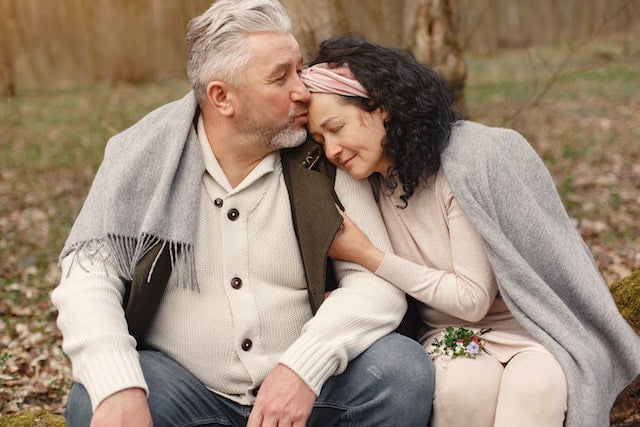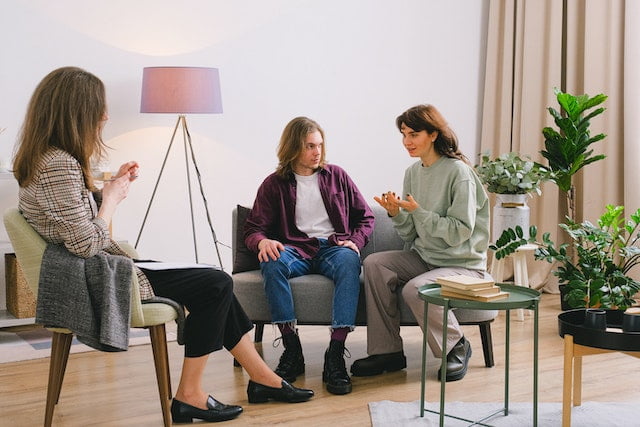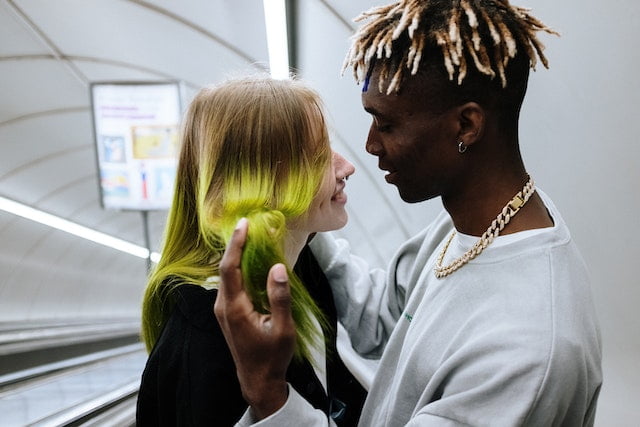Decoding the Language of Male and Female Relationships
Decoding the language of male and female relationships is a fascinating journey that allows us to understand the intricate dynamics between genders.
From subtle body language cues to nonverbal communication patterns, there is a rich tapestry of signals and expressions that can provide deep insights into the thoughts, emotions, and intentions of individuals.
In this article, we will explore the nuances of male and female communication, uncovering the hidden messages conveyed through eye contact, facial expressions, body movements, and more.
By understanding and deciphering these signals, we can bridge the communication gap, build stronger connections, and foster healthier relationships.
Decoding the Language of Male and Female Relationships: Unveiling the Silent Dialogue
Understanding Nonverbal Communication
Nonverbal communication is a powerful tool that plays a significant role in our interactions with others. It goes beyond spoken words and provides valuable insights into our thoughts, emotions, and intentions.
In this section, we will further explore the intricacies of nonverbal communication and delve into various aspects that shape our understanding of it.
The Power of Eye Contact:
Eye contact plays a crucial role in communication, conveying interest, attentiveness, and connection. Maintaining eye contact shows active engagement and indicates genuine involvement in the conversation.
In some cultures, prolonged eye contact may be seen as a sign of respect or assertiveness, while in others, it may be interpreted differently. Being aware of cultural differences is important to avoid miscommunication.
Facial Expressions:
Facial expressions are windows to our emotions. A smile can convey warmth and happiness, while a furrowed brow may indicate concern or confusion.
Research studies have shown that women tend to have more expressive facial features compared to men (Kring & Gordon, 1998). However, individuals of all genders can benefit from being mindful of their facial expressions to accurately express their emotions.
Body Movements and Posture:
Body movements and posture can reveal a lot about a person’s emotional state and level of comfort. Leaning in during a conversation signifies interest and engagement, while crossed arms or a turned-away body may indicate defensiveness or disinterest.
It is essential to pay close attention to body language cues, as they can provide valuable insights into the underlying emotions and intentions of individuals.
Communication Skills and Gender Differences

The Role of Nonverbal Behavior
Nonverbal behavior encompasses various elements such as gestures, facial expressions, body movements, and tone of voice. It is a powerful tool in conveying emotions and establishing rapport.
While research suggests that women may be more adept at decoding nonverbal cues (Hall, 2016), both genders can benefit from improving their nonverbal communication skills to enhance their understanding and connection with others.
Love Languages and Nonverbal Communication
Understanding each other’s love languages can greatly enhance communication in relationships. Love languages refer to the ways individuals give and receive love, such as through acts of service, physical touch, quality time, words of affirmation, or receiving gifts (Chapman, 1992).
Recognizing and aligning with your partner’s love language can help bridge any communication gaps and strengthen the emotional bond between you.
Hard Time: Navigating Nonverbal Cues
Nonverbal communication can become challenging when individuals are going through a hard time. During periods of stress, anxiety, or emotional turmoil, people may struggle to express themselves effectively through nonverbal cues.
Their facial expressions, body movements, and posture may be influenced by their emotional state, making it difficult to interpret their true intentions. It is crucial to approach such situations with empathy, providing support and understanding to those who may be experiencing a hard time.
The First Date: Nonverbal Impressions
A first date is a prime example of a situation where nonverbal communication plays a crucial role. Both individuals rely on nonverbal cues to form initial impressions and assess their compatibility.
Factors such as eye contact, facial expressions, and body language can influence the overall perception of the date. Making a genuine effort to engage in active nonverbal communication can help establish a positive connection and foster a promising start to a potential relationship.
Big Love: Nonverbal Affection
In established relationships, nonverbal communication serves as a vehicle for expressing love and affection. Simple gestures like a warm smile, a gentle touch, or a loving embrace can convey emotions that words sometimes fail to capture.
Nonverbal cues become even more vital during challenging times, as they can provide comfort, reassurance, and a sense of security to partners.
Good News and Dangerous Phrases: Nonverbal Reactions

Nonverbal communication also plays a role in how we react to good news and respond to dangerous phrases. Our facial expressions, body language, and tone of voice can reveal our true emotions and thoughts.
A genuine smile, accompanied by positive nonverbal cues, signifies joy and excitement. On the other hand, dangerous phrases may elicit defensive body language, such as crossed arms or a tense posture.
Being aware of our own nonverbal reactions and paying attention to those of others can enhance our ability to navigate conversations and relationships effectively.
Good Time with Friends: Nonverbal Connection
Nonverbal communication is not limited to romantic relationships. It plays a significant role in our interactions with friends, whether male or female.
Nonverbal cues like laughter, shared gestures, and expressions of empathy can strengthen the bond among friends. The ability to read and respond to nonverbal signals enables us to connect on a deeper level and build meaningful friendships.
Language Disorders and Nonverbal Communication
Language disorders can present unique challenges in nonverbal communication. Individuals with language disorders may rely more heavily on nonverbal cues to express themselves and understand others.
Occupational therapists and speech-language pathologists play a crucial role in helping individuals with language disorders develop effective nonverbal communication skills.
Through various techniques, such as visual aids, video clips, and speech pattern exercises, these professionals support individuals in expressing their thoughts and emotions in a nonverbal way.
The Real Deal: Authentic Nonverbal Expressions
Authenticity is key when it comes to nonverbal communication. Genuine smiles, natural body movements, and sincere eye contact convey honesty and trustworthiness.
Being aware of our own body language and striving for authenticity in our nonverbal expressions can lead to more meaningful connections and positive outcomes in our personal and professional relationships.
Constant Check-ins: Nonverbal Signals in Relationships
In relationships, constant check-ins through nonverbal signals play a vital role in understanding each other’s emotions and maintaining a strong connection.
Regular nonverbal cues such as a gentle touch, a knowing glance, or a comforting hug can communicate love, support, and empathy without the need for words.
These gestures serve as reminders of the emotional bond shared between partners and contribute to the overall health and happiness of the relationship.
Text Message Misinterpretations: Nonverbal Challenges
Nonverbal communication becomes particularly challenging in the realm of digital communication, such as text messages. Without the benefit of facial expressions, tone of voice, or body language, messages can easily be misinterpreted.
A harmless comment may be misconstrued as sarcasm or anger, leading to misunderstandings and conflicts. It is important to be mindful of this limitation and use clear and concise language to convey intentions accurately.
Adding emojis or emoticons can help provide some nonverbal context to digital conversations.
Best Friends and Nonverbal Synchrony

Nonverbal communication plays a significant role in the dynamics of best friendships as well. Close friends often develop a level of nonverbal synchrony, where they intuitively understand each other’s nonverbal cues and respond accordingly.
This synchrony allows for seamless communication, deep connection, and a sense of mutual understanding. Best friends can often communicate through subtle glances, shared laughter, or a mere nod, forming a nonverbal language unique to their bond.
Sex Differences in Nonverbal Communication
While there are general tendencies in nonverbal communication, it is important to recognize that individual differences within genders outweigh any broad generalizations.
However, research has identified some sex differences in nonverbal communication patterns. For example, studies suggest that women tend to be more expressive in their facial expressions and use more nonverbal cues to convey empathy and support.
Men, on the other hand, may exhibit different patterns of nonverbal behavior, influenced by cultural expectations and socialization.
It is essential to approach nonverbal communication with an open mind, acknowledging the diversity of expression within individuals of all genders.
Valentine’s Day: Nonverbal Expressions of Love
On Valentine’s Day, nonverbal expressions of love take center stage. Whether it’s a heartfelt embrace, a loving gaze, or a tender caress, these nonverbal acts reinforce the deep affection shared between partners.
Celebrating love on this special day goes beyond exchanging words; it involves consciously engaging in nonverbal communication that speaks volumes about our feelings and commitment to one another.
The Power of Positive Emotions: Nonverbal Uplift
Nonverbal communication is closely intertwined with our emotions. Positive emotions such as joy, happiness, and excitement tend to be contagious and can be conveyed through nonverbal cues.
A genuine smile, an enthusiastic gesture, or an animated conversation can uplift the mood of those around us. By harnessing the power of positive nonverbal expressions, we can create a more vibrant and harmonious social environment.
Navigating Bad Days: Nonverbal Support
On the flip side, nonverbal communication can provide much-needed support during challenging times. When someone is having a bad day, nonverbal cues like a comforting touch, a compassionate look, or a listening ear can convey empathy and understanding.
Nonverbal support serves as a reminder that we are not alone in our struggles and that there are people who genuinely care about our well-being.
Occupational Therapists and Nonverbal Communication

Occupational therapists play a crucial role in helping individuals with nonverbal challenges, including those with language disorders or difficulties in social communication.
Through various therapeutic techniques, they assist individuals in developing their nonverbal communication skills.
This can include activities focused on body language, facial expressions, and nonverbal interactions to enhance their ability to express themselves effectively and navigate social situations with confidence.
The Subtle Way of Nonverbal Communication
Nonverbal cues often operate on a subtle level, conveying messages beyond what words can express. A slight nod, a raised eyebrow, or a shift in body posture can communicate agreement, skepticism, or interest.
Paying attention to these subtle nonverbal signals allows us to pick up on nuances and gain a deeper understanding of the underlying meaning behind the spoken words.
Video Clips and Nonverbal Learning
Video clips can be powerful tools for studying and learning about nonverbal communication. By observing real-life interactions captured on video, we can analyze and dissect the intricacies of nonverbal behavior.
This visual medium provides a valuable resource for individuals to improve their own nonverbal communication skills and expand their understanding of the complexities of human interaction.
Speech Patterns and Nonverbal Cues
Speech patterns, including tone of voice, rhythm, and pitch, are closely linked to nonverbal communication. The way we speak can enhance or contradict the message we are trying to convey.
Interestingly, a soothing tone can convey empathy, while a sharp or aggressive tone can indicate hostility or frustration. Developing awareness of our own speech patterns and aligning them with our nonverbal cues can foster effective and harmonious communication.
Nonverbal Communication: The Real Deal
Nonverbal communication is the real deal when it comes to understanding others and establishing meaningful connections. It transcends cultural barriers, language differences, and even time.
Although nonverbal cues allow us to communicate on a deeper level, connecting with others in a way that words alone cannot achieve. By honing our nonverbal communication skills and being attuned to the nonverbal expressions of those around us. We can forge stronger relationships, create positive environments, and foster understanding.
Future Research and Nonverbal Communication
While extensive research has been conducted on nonverbal communication, there is still much to explore and discover. Future studies can delve deeper into the specific nonverbal cues associated with different emotions, cultures, and contexts.
By continuously expanding our knowledge in this field, we can gain further insights into the intricacies of nonverbal communication. Plus its impact on various aspects of our lives.
Different Outcomes: The Role of Nonverbal Communication
Importantly, nonverbal communication can lead to different outcomes depending on the context and the individuals involved. It can either enhance understanding, strengthen relationships. And foster positive interactions or contribute to misunderstandings, conflicts, and strained connections.
Recognizing the power of nonverbal cues empowers us to be more intentional and mindful in our communication, leading to more desirable outcomes in our personal and professional lives.
Widespread Belief: Nonverbal Universality
There is a widespread belief that certain nonverbal expressions, such as a genuine smile or a sign of attraction, are universal across cultures.
While research has identified commonalities in nonverbal communication. It is essential to acknowledge that there are also cultural variations that influence the interpretation of nonverbal cues.
It is important to approach nonverbal communication with cultural sensitivity, recognizing and respecting the diversity of expressions and interpretations.
Romantic Partners and Nonverbal Synchronization
In romantic partnerships, nonverbal synchronization plays a significant role in building intimacy and connection. Couples often develop a unique nonverbal language that is understood only by them.
And nonverbal cues become a shorthand way of communicating complex emotions, desires, and needs. Being attuned to each other’s nonverbal signals fosters a deeper sense of emotional closeness and strengthens the bond between romantic partners.
Classroom Teachers and Nonverbal Communication
Did you know Nonverbal communication is of utmost importance in educational settings, particularly for classroom teachers. Educators use a range of nonverbal cues. Such as facial expressions, body language, and gestures. To convey information, manage classroom dynamics, and create a positive learning environment.
Nonverbal cues can help teachers establish rapport with students, provide encouragement, and effectively manage classroom behavior. By being aware of their own nonverbal communication and understanding how students may interpret these cues.
Teachers can enhance student engagement, comprehension, and overall learning outcomes.
New Hairstyle, New Nonverbal Identity
With changes in appearance, such as a new hairstyle, can have an impact on our nonverbal communication. Altering our physical appearance can affect how others perceive us and interpret our nonverbal cues.
Plus, A new hairstyle may change our facial features, which in turn can influence the way we express emotions or convey messages through our facial expressions.
Being aware of these changes and understanding the potential effects of nonverbal communication can help us navigate social interactions with confidence.
Nonverbal Communication in Occupational Therapy
Occupational therapists recognize the importance of nonverbal communication in their practice. They understand that effective communication goes beyond verbal interactions and encompasses nonverbal cues as well.
Also, Occupational therapists employ various strategies to support individuals in improving their nonverbal communication skills. Which can enhance their overall participation in daily activities and social interactions.
Through tailored interventions and therapeutic techniques, occupational therapists help individuals develop and refine their nonverbal communication abilities. Fostering independence, confidence, and meaningful engagement.
Nonverbal Communication as a Sign of Attraction

Nonverbal communication often serves as a significant indicator of attraction between individuals.
Body language cues, such as leaning in closer, maintaining prolonged eye contact, mirroring each other’s movements, and gentle touches, can signify romantic interest.
Being attuned to these nonverbal signs can help individuals navigate the early stages of romantic relationships and determine mutual attraction.
The Power of Nonverbal Connection
Firstly, nonverbal communication is a powerful tool for engaging female readers. When writing content, incorporating nonverbal cues into descriptions and narratives can create a sense of connection and empathy.
By evoking the nonverbal experiences and emotions associated with a topic, female readers can relate on a deeper level. Leading to increased interest, understanding, and engagement.
Making Perfect Sense: Nonverbal Congruence
To ensure effective communication, it is crucial to maintain nonverbal congruence. Importantly, nonverbal cues should align with the verbal message being conveyed, ensuring consistency and clarity.
When there is a mismatch between verbal and nonverbal communication, confusion and misunderstandings can arise. Being mindful of our own body language, facial expressions, and tone of voice allows us to create congruence and establish trust in our interactions.
In conclusion, understanding nonverbal communication is key to deciphering the unspoken language that exists in male and female relationships.
From eye contact to body movements, these nonverbal cues provide valuable insights into our emotions, intentions, and connections with others.
By honing our nonverbal communication skills, we can enhance our relationships, navigate social interactions effectively, and foster understanding and empathy in all aspects of our lives.
8 Frequently Asked Questions About Decoding the Language of Male and Female Relationships
How can I improve my nonverbal communication skills in relationships?
Improving nonverbal communication skills in relationships starts with self-awareness. Pay attention to your own body language, facial expressions, and tone of voice.
Practice active listening and observe the nonverbal cues of your partner. Seek feedback and engage in open communication about nonverbal communication to better understand each other’s needs and preferences.
Can nonverbal communication help resolve conflicts in relationships?
Yes, nonverbal communication can play a vital role in resolving conflicts. By paying attention to nonverbal cues, such as body language and facial expressions, you can gain insight into your partner’s emotions and feelings.
This understanding can facilitate empathy and guide effective communication during challenging situations, leading to more productive conflict resolution.
Are there any gender differences in nonverbal communication?
Research suggests that there are some gender differences in nonverbal communication. For example, women tend to be more expressive in their facial expressions, while men may exhibit more dominant body language.
However, it’s important to remember that these differences are not absolute and can vary among individuals. Focus on understanding and interpreting the nonverbal cues of your partner as an individual, rather than making general assumptions based on gender stereotypes.
Can nonverbal communication impact the success of a first date?
Absolutely! Nonverbal communication plays a significant role in the success of a first date. It sets the tone for the interaction and conveys interest, attraction, and compatibility.
Pay attention to your own nonverbal cues and be attentive to those of your date. Maintain eye contact, display open body language, and engage in active listening to create a positive and engaging experience.
How can nonverbal communication enhance intimacy in romantic relationships?
Nonverbal communication is a powerful tool for enhancing intimacy in romantic relationships. By being attuned to each other’s nonverbal cues, you can deepen your emotional connection, understand each other’s needs and desires, and communicate love and affection in a nonverbal way.
Nonverbal gestures, such as physical touch, gentle eye contact, and genuine smiles, can create a sense of closeness and strengthen the bond between partners.
Can nonverbal communication be affected by language disorders?
Yes, individuals with language disorders may face challenges in expressing themselves verbally, which can impact their nonverbal communication as well. It’s important to be patient, understanding, and supportive when communicating with someone with a language disorder.
Focus on nonverbal cues, such as facial expressions and body language, and explore alternative forms of communication, such as visual aids or gestures, to facilitate understanding and connection.
How can I use nonverbal communication to show support for my friends?
Nonverbal communication can be a powerful way to show support for your friends. Listen actively, maintain eye contact, and provide positive reinforcement through nods, smiles, and comforting gestures.
Your nonverbal cues can convey empathy, understanding, and encouragement, which can strengthen your friendship and make your friends feel valued and supported.
Can nonverbal communication be misinterpreted?
Yes, nonverbal communication can be misinterpreted, as different individuals may assign different meanings to certain nonverbal cues. Cultural differences, personal experiences, and context can influence the interpretation of nonverbal communication.
It’s important to approach nonverbal cues with sensitivity and be open to clarifying any misunderstandings through verbal communication.
Decoding the Language of Male and Female Relationships Conclusion
Decoding the language of male and female relationships requires an understanding of nonverbal communication. From eye contact to facial expressions, body movements, and speech patterns, nonverbal cues provide a wealth of information about emotions, intentions, and connections.
By honing our ability to interpret and utilize nonverbal communication, we can deepen our understanding of others, improve our relationships, and foster effective communication.
Through this article, we have explored the power of eye contact in conveying interest and connection. We have delved into the significance of facial expressions and how they reflect our emotions.
Additionally, we have discussed the role of body movements and posture in revealing our emotional state and level of comfort.
Furthermore, we have examined various scenarios where nonverbal communication plays a crucial role. From first dates and romantic relationships to friendships and professional settings, nonverbal cues influence our interactions and shape the quality of our connections.
Understanding nonverbal communication is essential for building healthy and fulfilling relationships. It enables us to navigate social situations, convey empathy, and establish rapport.
Paying attention to our own nonverbal cues
By paying attention to our own nonverbal cues and being mindful of the signals others are sending, we can enhance our communication skills and foster stronger connections with those around us.
Furthermore, decoding the language of male and female relationships goes beyond verbal exchanges. Nonverbal communication provides a rich and nuanced understanding of our emotions, intentions, and connections.
By honing our ability to interpret and utilize nonverbal cues, we can enhance our relationships, foster effective communication, and create deeper and more meaningful connections with others.
Remember, nonverbal communication is a language of its own, and by becoming fluent in this language, we open the door to a world of understanding, empathy, and connection.
So, pay attention to the unspoken cues, embrace the power of nonverbal communication, and watch as your relationships flourish.
Finally, decoding the language of male and female relationships is a lifelong journey filled with intrigue and discovery. By paying close attention to nonverbal cues, such as eye contact, facial expressions, and body movements
